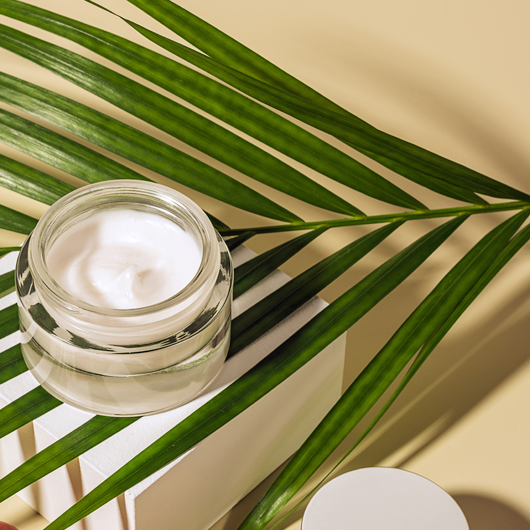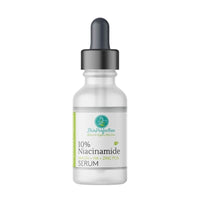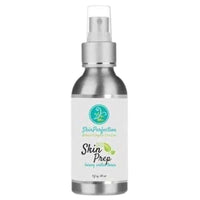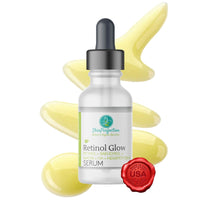Hyaluronic Acid
Moisturize with Hyaluronic Acid

Scientific Name: Hyaluronan, Hyaluronic Acid, Sodium Hyaluronate, NASHA, Hyaluron, Hyalu, HA, Sodium Hyaluronate Crosspolymer, Hydrolyzed Hyaluronic Acid
Common Name: Hyaluronic Acid
Forms: Liquid, Gel, Serum, Powder, Encapsulated, Time-released, Facial Cream.
Appearance: Typically, a clear gel. It may or may not have bubbles. The powder is white.
Are you looking for the secret to younger, more beautiful skin? You're not alone.
The average person spends almost $60 per month on beauty products. But what if the secret to beautiful, healthier-looking skin is cheaper than you think?
Say goodbye to overpriced products filled with a long list of chemicals you can't pronounce!
Instead, with some knowledge and know-how, you can welcome more natural products into your life and help put your best face forward.
Many skincare ingredients have become popular. However, trendy ingredients come and go. The best ingredients that really work stick around and become our tried-and-tested best-sellers.
One of those ingredients is Hyaluronic Acid. And it's one that you should be using in your anti-aging skincare routine.
What is Hyaluronic Acid?
You're likely more familiar with Hyaluronic Acid than you think. This acid is the active ingredient in some of the market's most popular serums, masks, and injectables. But it's also found right inside your body!
Used to beautify skin, Hyaluronic Acid (also known as HA) is a natural substance in your body that stores water and helps keep skin plump and hydrated.
Not only does HA hydrate your skin, but it also holds a thousand times its weight in water, preventing moisture from escaping. It also keeps your body tissue moist and lubricated.
Adequately hydrated skin looks younger, smoother, and healthier. You're also less likely to experience skin irritation, dermatitis, and redness.
HA helps reduce the appearance of fine lines and wrinkles by plumping up the skin.
As you age, your body's natural Hyaluronic Acid level decreases, so you must add this ingredient to your daily routine.
Other factors that decrease your body's HA production include smoking tobacco, exposure to ultraviolet rays, and pollution.
Hyaluronic Acid, or HA, locks in moisture, deeply hydrates, and restores fullness to the face. It supports the layers of skin along with collagen and elastin.
There are two different types: low and high molecular. Both forms can be either bioengineered or come from animals.
At Skin Perfection, we only use NASHA from non-animal stabilized Hyaluronic Acid.
What does Hyaluronic Acid do?
It moisturizes your skin. Looking at those with youthful complexions, you will notice how full, plump, and supple their faces look. This is because it's smooth, not creased. In addition, elasticity keeps the jawline firm.
Those with younger complexions look healthy and vibrant. HA adds moisture back to your skin. It revitalizes your face for a more supple, smoother appearance. It gives added volume and plumps up with hydration. So your skin looks more radiant and hydrated but feels softer.
Humectants draw moisture in from the air. The added hydration can keep your skin looking supple throughout the day. It instantly increases your skin's hydration levels for fewer fine lines and wrinkles on the surface. There is no other faster topical application to plump the derma.
Why Should You Use Hyaluronic Acid?
Hyaluronic Acid is a gel that intensely hydrates your face — plumping your facial features for a more supple, youthful complexion.
It is the same ingredient used in injections such as Restalyne and Juvederm. Hyaluronic Acid expands a thousand times its weight in water.
You can use Hyaluronic Acid topically. It plumps up areas such as marionette lines and lips for a supple, youthful complexion.
HA was initially used as a skincare delivery agent. Once discovered, it was immediately put into cosmetics to deliver moisture and nutrients for a supple appearance, adding fullness to the face.
Researchers later found that it had great value as a skincare ingredient, as it helped the skin retain moisture, leading to healthier facial features.
It works by plumping up the skin and turning back the aging process. Added volume increases the outer layer of skin, smoothing creases. In addition, it contributes to restoring vital connective tissue and providing the natural moisture your skin needs to stay healthy and radiant.

Older Skin
As we age, our body destroys its natural hyaluronic acid deposits. As a result, our natural supply of collagen and elastin stores diminishes.
A diet full of toxins accelerates this process, making it harder for our skin to retain its natural fullness. Further, moisture retention and cell regeneration are the main features of a youthful appearance.
As the Hyaluronic Acid leeches away, so does the plump, radiant complexion. Adding HA to a healthy skincare regimen can stop natural aging and reduce the look of fine lines and wrinkles.
Don't be frightened by the word "acid"! It's nothing like those dangerous, corrosive acids! It's more similar to fatty acids or protein.
Adequately moisturized complexions are full and plump; the cells are stable, and the regeneration rate is fast enough to replace and push out dead cells.
However, many women need help getting this effect. Instead, skin becomes too dry, exacerbating an already dull appearance. Or, occasionally, too oily, making the skin look older.
Natural Ways to Increase Hyaluronic Acid
Since HA is produced in your body naturally, specific lifestyle changes can support and boost their production.
Diet is a big part of this process. Fruits and vegetables high in antioxidants help protect your skin from inflammation and retain moisture. Additionally, citrus fruits, including lemons, limes, and oranges, are beneficial.
Natural and organic anti-aging products also benefit from introducing HA back into your body.
You're lucky if your daily skincare regime includes retinol, peels, and other acids! Hyaluronic acid interacts well with most other ingredients. Just beware of products that contain low pH levels. These may render HA ineffective.
How to Choose the Right Hyaluronic Acid Product
There are countless ways to beautify your skin, but if your routine doesn't include a product high in Hyaluronic Acid, you could be missing an essential step.
The product you choose should have a 1% concentration of HA. Anything higher might cause skin irritation. Also, the best Hyaluronic Acid products don't contain added ingredients like alcohol or sulfates, which can cause complications.
Instead, opt for products that are fragrance-free, paraben-free, and cruelty-free.
Serums work best since HA doesn't contain any water itself. When added to a high-quality serum, Hyaluronic Acid quickly penetrates and absorbs into the skin.
Using Peptides and Hyaluronic Acid Together
Peptides are the foundation of healthy skin. They are short chains of amino acids that help create elastin, collagen, and keratin in your skin. These proteins maintain your skin's smooth texture, resilience, and strength.
Peptides also work as signals that tell your body it needs to heal. For example, when peptides are added to your skin, your body produces more collagen to help repair the area. This can lead to fuller, firmer-looking skin.
But can you use peptides and HA together?
The answer is yes, but some peptides interact better with hyaluronic acid products than others.
Carrier peptides, for example, help deliver minerals to the skin that boost collagen production. Likewise, they signal peptides to promote your body's production of collagen, elastin, and other vital proteins.
Neurotransmitter peptides are "Botox-like" and help block the release of chemicals that cause expression lines. These peptides can also help smooth out and reduce visible wrinkles.
Lastly, enzyme inhibitor peptides slow your body's natural response to break down collagen.
Combining any of these peptides with Hyaluronic Acid will only enhance their effects.
How to Use Hyaluronic Acid
Apply Hyaluronic Acid topically to help work deep into the skin to strengthen cells; it causes cells to better hold onto the skin's moisture.
HA expands a thousand times its weight in water, helping skin cells look fuller while plumping areas such as marionette lines and lips for a supple complexion.
Finally, you can add HA to an anti-aging product to rev up its results or use it individually.
It may replace more caustic treatments, as it is designed to be skin-friendly instead of drying and abrasive like some other anti-aging treatments.
Recently, it has become the primary ingredient used in injectable facial fillers such as Restalyne and Juvederm.
Try a serum with Hyaluronic Acid, and you will see the skin-plumping volume difference. Bring volume and suppleness back to your skin today!
How to Make a Hyaluronic Acid Serum on a Dime Budget
- 2.4 oz. Distilled Water
- 0.48 oz. Leucidal® Liquid Complete
- 0.12 oz. Sodium Hyaluronate Powder
Combine Distilled Water and Leucidal® Liquid Complete. Sprinkle in Sodium Hyaluronate and stir. Let hydrate anywhere from 2 to 24 hours. Once wholly hydrated, the mixture will thicken to a uniform consistency. This recipe will make approximately 4 ounces of serum. Leucidal® is a trademark of Active Micro-Technologies.
Hyaluronic Plump and Glow Recipe
Got Maskne? What is Maskne? This is for those experiencing acne breakouts due to wearing facial masks and the coronavirus. Here is an easy DIY gel that will help keep your skin clean.
- 1 oz. Hyaluronic Acid Gel
- 1/8 tsp. Vegetable Glycerin
- 1/8 tsp.Leucidal® SF Max
- 5 drops of Tea Tree Essential Oil
- 5 drops of Organic Lavender Essential Oil
- 2 drops Clary Sage
Add glycerin, Leucidal® SF Max, and essential oils to your Hyaluronic Acid Gel Base and mix. Shake well before each use. Avoid use around the eye area.
Hyaluronic and Collagen Facial Serum Recipe
- 1 oz. Hyaluronic Acid Gel
- 1/8 tsp. Vegetable Glycerin
- 18 drops of Liquid Collagen
The Best Skincare Tools to Use with Hyaluronic Acid
Want to boost your beauty game even more? Here are a few of the best skin care tools and HA for better results.
LED Light Therapy
While overexposure to sunlight causes premature aging, LED Light Therapy encourages your skin to regenerate.
LED wavelengths penetrate deep into your skin, stimulating collagen production and providing anti-aging benefits.
Blue light improves overall complexion and eliminates acne-causing bacteria.
Microcurrent
Adding a microcurrent tool to your regime can enhance results. For example, microcurrents and light therapy can improve skin elasticity by retraining facial muscles.
This combination therapy leaves your skin looking and feeling firmer.
Derma Roller
This handheld needling device helps improve circulation and cell turnover. In addition, using a derma roller consistently can help the overall appearance of your complexion. As a result, you are increasing the smoothness and brightness of your skin.
Benefits of Hyaluronic Acid
- Visibly Plumping
- Improves Hydration Content
- Supple Look
- Smoother Appearance
- Improved Elasticity
- Healthier Outer Lipid Barrier
- Powerful Humectant
- The Ultimate in Oil-free Hydration
Additional Benefits of Hyaluronic Acid
One of the best features of HA is that it's a natural acid produced in your body. That means products containing hyaluronic acid are safe to use all over your body.
HA can help ease sore, stiff joints and bones with a natural lubricant. In addition, as it speeds up the body's production of proteins, Hyaluronic Acid can also speed up the regeneration process in your body.
Hyaluronic acid injectables are available and widely used to reshape specific body areas for cosmetic and medical reasons. This can lead to boosted confidence and overall better health.
The Hydration Hero: 5 Skin Benefits of Hyaluronic Acid
Hyaluronic acid, often referred to as the "hydration hero," offers numerous benefits for the skin:
- Intense Hydration: Hyaluronic Acid has an exceptional ability to hold water molecules, ensuring deep hydration and plumping of the skin, resulting in a smoother, more youthful appearance.
- Reduced Fine Lines and Wrinkles: By attracting and retaining moisture, Hyaluronic Acid helps diminish the appearance of fine lines and wrinkles, creating a more youthful and radiant complexion.
- Enhanced Skin Elasticity: Improved hydration contributes to increased skin elasticity, making it more resilient and less prone to sagging or loss of firmness.
- Balanced Oil Production: Hyaluronic Acid can regulate sebum production, making it suitable for all skin types, including oily and acne-prone skin, without causing breakouts.
- Soothing and Calming: Its gentle, non-irritating properties make it ideal for soothing and calming sensitive or irritated skin, relieving redness and inflammation.
Beauty Is In the Eye of the Beholder
Who knew that the secret to younger-looking skin already existed within you? Similar to collagen, your body naturally produces Hyaluronic Acid.
HA is responsible for keeping your skin moisturized and looking plump and healthy.
While nothing can turn back the hands of time, Hyaluronic Acid and related products can improve your skin's appearance and return its natural glow.
Are you looking for all-natural, organic products? Browse our facial care products and find other solutions here.
Are there any side effects of Hyaluronic Acid?
There are no known side effects of using HA. It's a great product that many individuals, including those with sensitive skin or chemical sensitivities, can use. In addition, it is a naturally occurring substance already in our bodies.
What is the difference between High Molecular and Low Molecular?
High molecular weight Hyaluronic Acid is generally used for dermal filling and plumping. Plumping HA is often found in serums but can be included in beauty creams.
High molecular is beneficial for dry complexions that need visible plumping.
On the other hand, low molecular penetration of the epidermis is better and increases the effectiveness of Hyaluronic Acid. A low molecular formula is recommended for those who want their anti-aging peptides to work better. However, you won't get the plumping effects like the other version.
Choose a high and low-molecular product containing multiple HA sources if you want the best of both worlds.
Serums VS Supplements
HA serums offer several advantages over supplements.
Firstly, serums provide direct and targeted application to the skin, delivering concentrated hyaluronic acid where it's needed most. This helps to hydrate and plump the skin, reducing the appearance of fine lines and wrinkles.
Secondly, serums can be used topically alongside other skincare products, allowing for a comprehensive skincare routine that addresses multiple concerns simultaneously.
Lastly, hyaluronic acid serums work quickly, providing immediate results and visible skin texture and hydration improvements. At the same time, supplements may take time to show noticeable effects as they need to be absorbed and distributed throughout the body.
Answers to the Most Asked Questions About Hyaluronic Acid
Why does Everyone Rave about Hyaluronic Acid?Hyaluronic acid is a hydrator that is naturally found in tissue. HA plays a crucial role in skin and its ability to retain moisture. When applied topically, HA helps to keep the skin plumped, hydrated, and youthful-looking. Its moisture-binding property helps improve skin elasticity and minimize the look of fine lines and wrinkles.
Why is HA important?HA is vital because of its unique ability to retain moisture in the skin, joints, and eyes, among other tissues. In the skin, it provides hydration and helps maintain skin structure, including elasticity. As we age, HA decreases, resulting in drier, less elastic skin. Supplementing with topical HA products can help counteract these effects.
Is it okay to use HA every day? Yes, it's generally safe to use hyaluronic acid daily. It's gentle, suitable for various skin types, and provides consistent hydration benefits.
What else can hyaluronic acid do?Beyond skin hydration, hyaluronic acid has other applications. It's used in eye surgeries as a filler to replace natural eye fluids and in joint injections to relieve osteoarthritis pain. HA, dermal fillers are also popular in aesthetic medicine to plump lips, restore cheek volume, and reduce wrinkles' appearance.
Does hyaluronic acid have any side effects?Topically applied hyaluronic acid is generally considered safe with minimal side effects.
Unveiling the Magic of Hyaluronic Acid and Other Humectants in Skincare
In the vast landscape of skincare ingredients, humectants are essential hydrating agents that draw moisture from the environment into the skin, leaving it plump, supple, and revitalized. Among the plethora of humectants, hyaluronic acid reigns supreme, renowned for its unparalleled ability to attract and retain moisture. In this article, we'll delve into the wonders of hyaluronic acid as a superior humectant, explore the benefits of other natural humectants, and conclude with insights on leveraging different humectants to optimize skincare routines.
Understanding Hyaluronic Acid: The Gold Standard of Humectants
Hyaluronic acid, often dubbed the "fountain of youth" in skincare, is a naturally occurring substance found in the skin that plays a crucial role in maintaining hydration levels. As a humectant, hyaluronic acid possesses an exceptional ability to attract and retain water molecules, holding up to 1000 times its weight in moisture. This remarkable capacity makes hyaluronic acid an indispensable ingredient in skincare formulations, offering intense hydration and plumping effects for all skin types.
Benefits of Hyaluronic Acid in Skincare
The benefits of hyaluronic acid extend beyond hydration, encompassing a spectrum of skincare advantages. Firstly, hyaluronic acid helps fortify the skin's natural barrier, enhancing its resilience against external stressors and environmental pollutants. Additionally, its humectant properties contribute to improved skin elasticity, firmness, and smoothness, reducing the appearance of fine lines and wrinkles. Moreover, hyaluronic acid is soothing and anti-inflammatory, making it suitable for sensitive or irritated skin. Incorporating hyaluronic acid into skincare routines can result in a more radiant, youthful complexion.
Exploring Natural Humectants in Skincare
While hyaluronic acid takes center stage, several other natural humectants offer exceptional benefits for skincare.
- Beta Glucan, derived from oats or mushrooms, stimulates collagen synthesis and enhances skin hydration, resulting in a smoother, more youthful appearance.
- Cassia Angustifolia, derived from the Indian Senna plant, exhibits hyaluronic acid-like effects, attracting moisture to the skin and enhancing its natural barrier function.
- Centella Asiatica, also known as "tiger grass," boasts antioxidant and skin-regenerating properties, aiding in moisture retention and skin rejuvenation.
- Hyaluronic Acid, a bio-fermentation, contributes to improved skin elasticity, firmness, and smoothness, reducing the appearance of fine lines and wrinkles.
- Prickly Pear, rich in vitamins and antioxidants, replenishes moisture levels and supports collagen production, promoting firmness and elasticity.
- Snow mushroom, revered for their hydrating properties, forms a moisture-retaining film on the skin's surface, locking in hydration and promoting a plump, dewy complexion.
- Vegetable Glycerin effectively draws moisture from the environment into the skin, providing instant hydration and a plumping effect.
Insights on Humectants Used in Skin Care
Natural humectants are commonly utilized in skincare formulations. Glycerin, a widely used natural humectant, effectively draws moisture from the environment into the skin, providing instant hydration and plumping effects. Glycols are another humectant that enhances skincare products' efficacy by improving their penetration and absorption into the skin. While glycol humectants offer hydration benefits, they may not possess the same skin-nourishing properties as natural alternatives.
Optimizing Skincare with Different Humectants
When it comes to skincare, diversity is key. Incorporating a variety of humectants into your skincare routine can maximize hydration and address specific skin concerns. For instance, layering hyaluronic acid serums with snow mushroom-infused moisturizers can create a potent hydration cocktail, delivering deep moisture and promoting skin resilience. Alternatively, incorporating products containing Cassia Angustifolia or Centella Asiatica can provide soothing relief for sensitive or inflamed skin. At the same time, Prickly Pear and Beta Glucan offer antioxidant-rich hydration for a youthful glow. By strategically combining different humectants, you can tailor your skincare regimen to meet your skin's unique needs and achieve optimal results.
In conclusion, humectants play a vital role in skincare, offering unparalleled hydration and rejuvenation for the skin. The possibilities for skincare enhancement are endless, from the legendary hyaluronic acid to an array of natural humectants. By harnessing the power of various humectants and incorporating them into your daily routine, you can unlock the secret to radiant, youthful skin.
Want more information? Contact us today!
Sources:
- https://www.ncbi.nlm.nih.gov/pmc/articles/PMC2582886/
- https://www.ewg.org/skindeep/ingredient/702887/HYALURONIC_ACID/
- https://www.today.com/style/what-hyaluronic-acid-hyaluronic-acid-s-benefits-skin-care-t152710
- Baumann, Leslie. "The Skin Type Solution." Bantam.
- Park, Hyun, et al. "Anti-Inflammatory and Skin Barrier Repair Effects of Topical Application of Some Plant Oils." International Journal of Molecular Sciences, vol. 19, no. 1, 2018, p. 70., doi:10.3390/ijms19010070.
- Schagen, Silke K., et al. "Discovering the Link between Nutrition and Skin Aging." Dermato-Endocrinology, vol. 4, no. 3, 2012, pp. 298–307., doi:10.4161/derm.22876.
About the Author
Kari Thomas wrote this article.



















